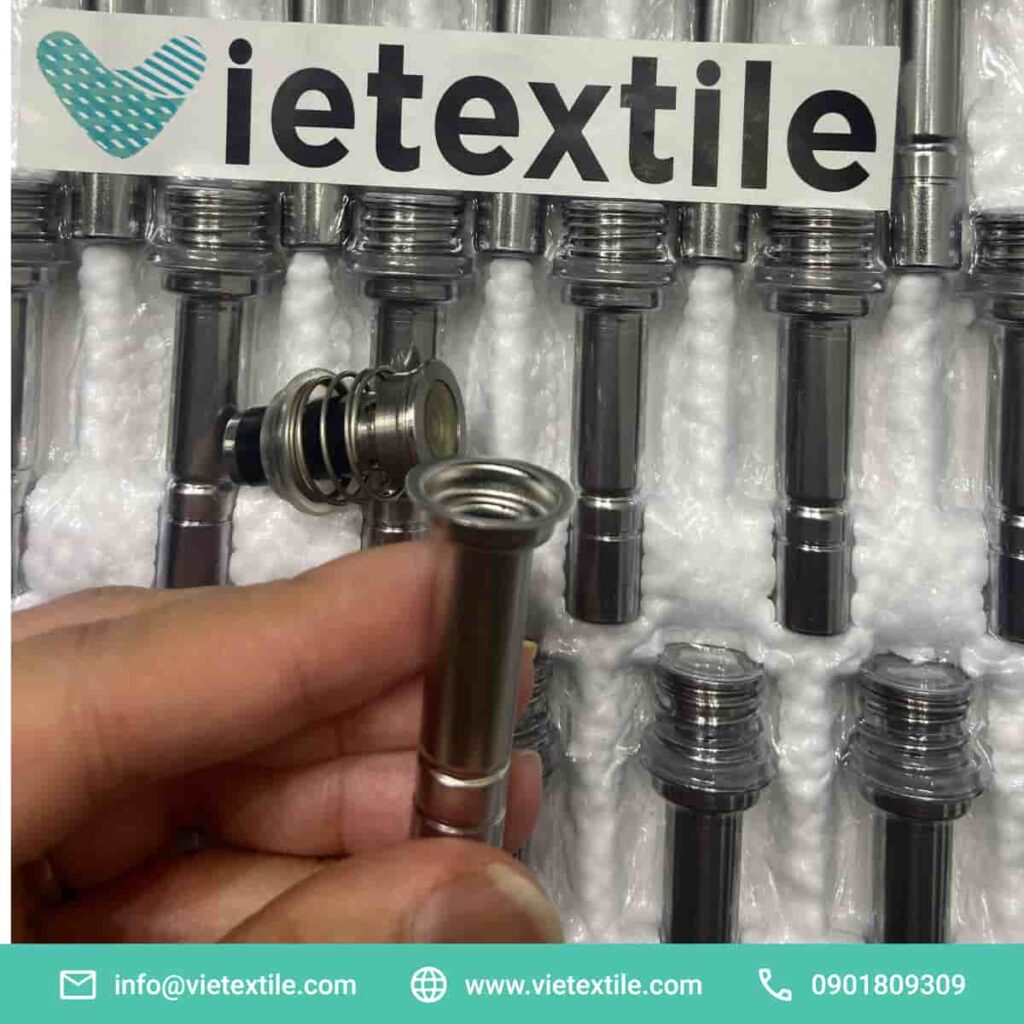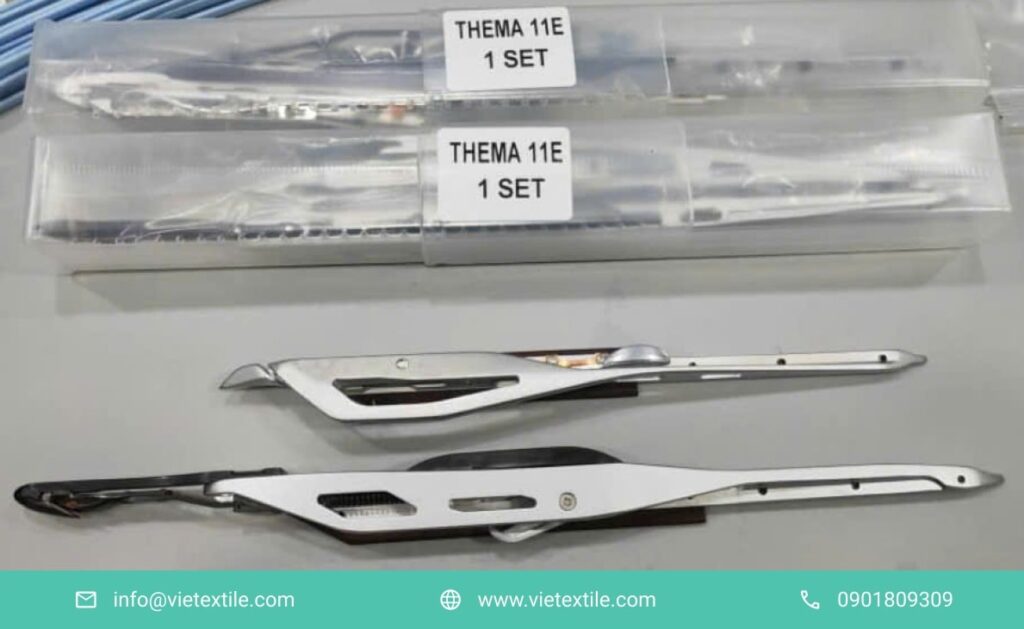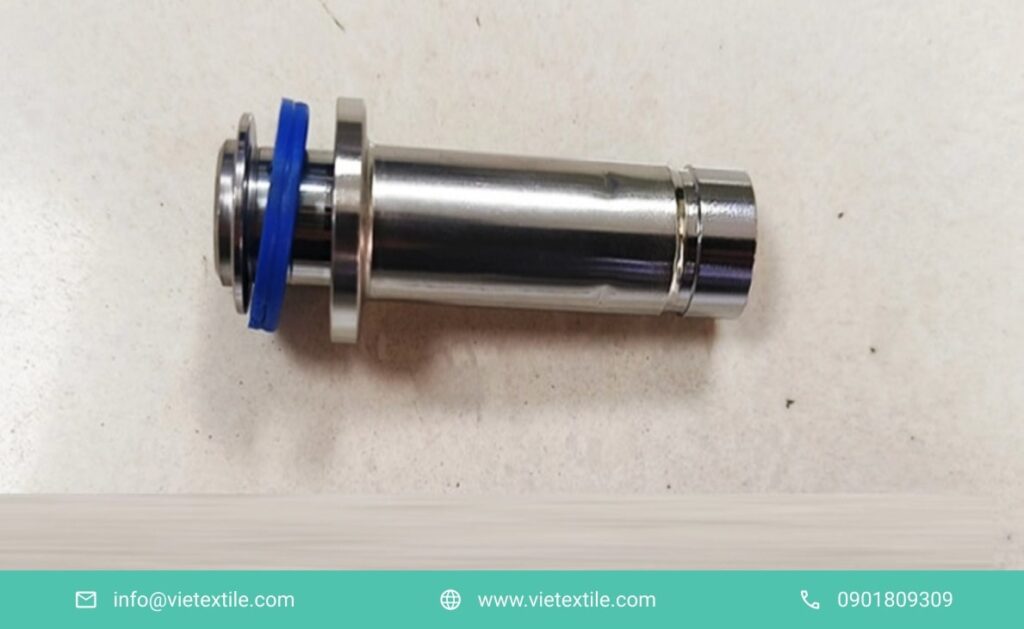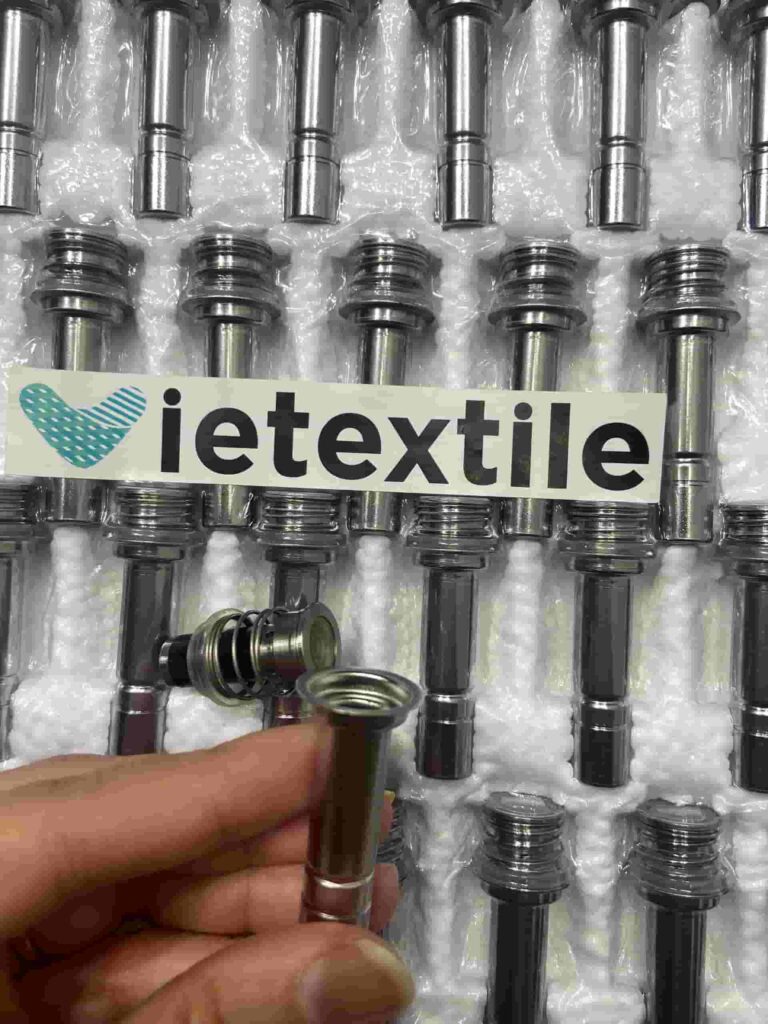In the textile industry, flat knitting machines play a central role in producing high-quality knitted products, from sweaters and scarves to technical fabrics. However, during operation, flat knitting machines are prone to malfunctions, especially fabric defects. One of the leading causes of these defects is the failure of flat knitting machine parts. Early identification and timely resolution of these defects are crucial to ensure product quality, optimize productivity, and minimize production costs.
Fabric defects not only affect the aesthetic appeal of the product but also lead to wasted raw materials, time, and effort. For knitting factories, controlling fabric quality right from the production stage is a vital factor in maintaining reputation and competitiveness in the market.
This article will delve into identifying fabric defects caused by faulty flat knitting machine parts, analyzing specific causes from each type of part, and proposing effective resolution procedures. The goal is to provide a comprehensive overview, helping technicians and production managers be more proactive in maintaining, repairing, and improving the quality of knitted products.

1. The Importance of Flat Knitting Machine Parts in High-Quality Fabric Production
Nội dung tóm tắt
ToggleA flat knitting machine is a complex system with thousands of small components working in synchronization. Each flat knitting machine part has its own function, contributing to the precision and stability of the knitting process. Therefore, the quality and condition of the parts directly affect the quality of the output fabric product.
1.1. Ensuring Knitting Process Precision
Flat knitting machines operate based on the harmonious coordination of needles, sinkers, yarn feeders, and other control components to create each stitch. Every flat knitting machine part must operate with high precision to ensure uniform stitches, correct size, and no defects. For example, knitting needles must be straight, not bent; sinkers must hold the yarn firmly; yarn feeders must supply yarn smoothly and in the correct position.
If any flat knitting machine part is worn, deformed, or damaged, it can disrupt the knitting process, leading to defects such as uneven stitches, dropped stitches, or yarn breakage. This not only affects fabric quality but also reduces machine operating efficiency, requiring machine downtime for repairs, wasting time and resources.
1.2. Direct Impact on Fabric Quality and Aesthetics
The quality and aesthetic appeal of knitted fabric largely depend on the condition of the flat knitting machine parts. A dull needle can damage the yarn, causing scratches or yarn breaks on the fabric. An uneven take-down roller can cause the fabric to wrinkle or deform, affecting the size and shape of the final product.
Minor defects caused by faulty parts can accumulate, forming major flaws in the fabric, rendering the product below quality standards and requiring rejection. This not only causes economic loss but also affects the manufacturer’s reputation. Therefore, maintaining flat knitting machine parts in good condition is a key factor in ensuring high-quality knitted fabric with a smooth surface and meeting aesthetic requirements.
1.3. Optimizing Productivity and Reducing Production Costs
Using genuine flat knitting machine parts and performing periodic maintenance helps the machine operate stably, minimizing downtime due to malfunctions. This directly increases production productivity, allowing the factory to complete more orders within the same timeframe.
Conversely, when parts are damaged, the machine will have to stop for repairs, wasting time and incurring labor costs and part replacement costs. Furthermore, producing defective fabric wastes raw materials and incurs reprocessing or disposal costs. By investing in quality flat knitting machine parts and maintaining them in good condition, businesses can optimize operating costs, minimize waste, and improve overall profitability.
2. Common Fabric Defects Caused by Faulty Flat Knitting Machine Parts
Fabric defects on flat knitting machines are diverse, but most can be traced back to the failure or wear of specific flat knitting machine parts. Correctly identifying the type of defect will help determine the cause and effective solution.

2.1. Yarn Breakage/Jamming
Yarn breakage or jamming is one of the most common problems, disrupting the knitting process and wasting yarn. Causes from parts:
- Bent, broken, or dull needles: Deformed or sharp-edged needles can break the yarn as it passes through or as the needle moves. Dull needles also increase friction, causing yarn breakage.
- Worn or misaligned Yarn Feeder: A worn or improperly aligned yarn feeder can cause excessive friction on the yarn, or fail to guide the yarn correctly into the needle’s position, leading to yarn breakage or jamming.
- Faulty Yarn Gripper: If the yarn gripper does not hold the yarn firmly or grips it too tightly, it can break the yarn when pulled.
- Damaged Yarn Guide Wheel: A scratched or worn surface of the guide wheel can damage the yarn as it passes through.
2.2. Uneven Stitches/Dropped Stitches
This defect reduces the quality and aesthetic appeal of the fabric, creating holes or thinner areas in the fabric. Causes from parts:
- Dull, bent, or jammed needles: Needles cannot catch the yarn or release the stitch accurately. A jammed needle in the groove can also cause dropped stitches.
- Faulty Sinker: A worn, bent, or unsynchronized sinker with the needle may not hold the old stitch, leading to dropped stitches or uneven stitches.
- Inaccurate Needle Pusher: If the needle pusher does not push the needle up/down at the correct position and time, the stitch will not be formed properly.
- Unstable Yarn Tensioner system: Uneven yarn tension can cause some stitches to be too loose or too tight, leading to uneven fabric loops.
2.3. Fabric Tears/Scratches
This defect usually appears as small tears, scratches, or holes on the fabric surface. Causes from parts:
- Broken or sharp-edged needles: Broken needles or fragments of broken needles remaining in the machine can scratch or tear the fabric.
- Damaged Needle Bed: A scratched, worn, or sharp-pointed surface of the needle bed can damage the fabric as it moves across.
- Faulty Take-down Roller: A worn, dirty, or uneven take-down roller can tear the fabric when pulling.
- Damaged Fabric Clamp: A clamp that is too tight or has sharp edges can cause fabric tears at the edges.
2.4. Fabric Stains/Oil Marks
Grease stains on fabric are often very difficult to remove, reducing product value. Causes from parts:
- Faulty needle lubrication system: If the needle lubrication system leaks oil or uses too much oil, oil can stick to the yarn and fabric.
- Old or dirty lubricating oil: Lubricating oil that is not replaced periodically or is contaminated can stick to the fabric, creating stains.
- Non-functional Needle Cleaner: If this part is damaged or clogged, dirt and excess oil on the needles are not removed, easily sticking to the fabric.
- Dirty machine area: Accumulated dust and lint in the machine can stick to the fabric during knitting.
2.5. Fabric Wrinkles/Deformation
This defect affects the shape and size of the fabric, causing difficulties in subsequent finishing stages. Causes from parts:
- Uneven Take-down Roller: If the take-down rollers do not operate synchronously or are unevenly worn, the fabric can be pulled unevenly, causing wrinkles or deformation.
- Faulty Fabric Tensioning System: If the fabric tensioning system does not maintain stable tension, the fabric can become slack or over-tensioned, leading to wrinkles or structural deformation.
- Bent/Misaligned Fabric Holder Bar: A bent or improperly aligned fabric holder bar can cause the fabric to bunch up or be pulled off-center.
2.6. Fabric Skew/Incorrect Dimensions
This defect is often related to asynchronous fabric transport. Causes from parts:
- Asynchronous Take-down Roller: If the rotation speed of the take-down rollers is uneven, the fabric can be pulled off-center, leading to fabric skew.
- Faulty Position Sensor: The sensor does not provide accurate data on the fabric’s position or speed, preventing the control system from making correct adjustments.
- Faulty Take-down Motor: The motor not operating stably or losing synchronization can affect the fabric pulling speed.
3. Identifying Fabric Defects and Determining Causes from Flat Knitting Machine Parts
Identifying fabric defects is not just about detecting flaws but also about tracing the root cause back to faulty flat knitting machine parts. A systematic inspection process will help optimize repair time and costs.
3.1. Visual Inspection and Fabric Examination
The first step is to carefully observe the defective fabric sample.
- Inspect the entire length and width of the fabric: Determine if the defect appears at a fixed position, repeats cyclically, or is random. Cyclically repeating defects often indicate a problem with a rotating part or a specific needle.
- Analyze the characteristics of the defect: Tears, holes, stains, uneven stitches, abnormal tension… Each type of defect can suggest a cause from the corresponding flat knitting machine part. For example, a horizontal line on the fabric might be due to a broken needle.
- Detailed record-keeping: Record the type of defect, location, frequency of occurrence, and any other abnormalities to serve as a basis for subsequent diagnosis.
3.2. Inspecting the Condition of Related Flat Knitting Machine Parts
After identifying defects on the fabric, proceed to inspect the flat knitting machine parts that could potentially cause the defect.
- Inspect needles: Check each needle on the needle bed for bends, breaks, dullness, or jamming in the groove. Use a magnifying glass to detect small cracks or sharp edges.
- Inspect yarn feeder: Ensure the yarn feeder is not worn, has no scratches, and is correctly aligned. Check the yarn tensioning system to ensure stable tension.
- Inspect sinkers: Examine sinkers for deformation, wear, or foreign objects stuck in them. Ensure they move smoothly.
- Inspect take-down unit: Check the take-down rollers for wear, dirt buildup, or uneven operation. Ensure they pull the fabric gently and synchronously.
- Inspect lubrication system: Ensure the lubrication system operates normally, with no excess oil leakage and clean lubricating oil.
- Inspect other components: Depending on the type of defect, it may be necessary to inspect sensors, valves, or other mechanical components.
3.3. Analyzing Data from Machine Monitoring System (If Available)
Modern flat knitting machines are often equipped with electronic monitoring and control systems.
- Check Error Log: The system may record generated errors, warnings about the condition of flat knitting machine parts, or abnormal operating parameters.
- Monitor operating parameters: Monitor parameters such as knitting speed, temperature, pressure, yarn tension to detect deviations from standards.
- Analyze historical data: Historical data can help identify trends in failures of certain flat knitting machine parts, thereby enabling more effective preventive maintenance planning.
3.4. Recording and Classifying Defects
Systematic recording and classification of defects are crucial for quality management and maintenance.
- Create defect records: Detail the defect (type of defect, cause, faulty part, repair date, person who performed the repair).
- Classify by cause: Classify defects by main cause (e.g., needle defect, yarn feeder defect, take-down system defect). This helps identify which flat knitting machine parts frequently cause problems.
- Analyze frequency: Track the frequency of each type of defect to prioritize maintenance and part replacement activities.
4. Procedure for Resolving Fabric Defects Caused by Faulty Flat Knitting Machine Parts
After identifying the defect and determining the cause, defect resolution should be carried out according to a standard procedure to ensure effectiveness and safety.

4.1. Safe Machine Shutdown and Isolation of Defective Area
When a fabric defect is detected, the first step is to safely shut down the flat knitting machine.
- Press emergency stop button: If the defect is severe or poses a risk of greater damage.
- Routine shutdown: For minor defects, shut down the machine according to standard operating procedures to avoid further damage to the fabric or machine.
- Isolate defective area: Accurately identify the defect location on the fabric and on the machine. Mark the defective fabric area for later removal.
- Ensure safety: Disconnect power, pressure (if any), and ensure no parts are moving before proceeding with inspection or repair.
4.2. Precisely Identifying the Faulty Flat Knitting Machine Part
Based on observation of fabric defects and machine inspection, precisely identify the faulty flat knitting machine part.
- Cross-reference with defect types: Based on the analysis in Section 2, cross-reference the fabric defect type with part-related causes to narrow down the area.
- Thorough inspection: Perform detailed inspection of suspected parts. For example, if there are dropped stitches, check each needle and sinker in that area.
- Use auxiliary tools: Magnifying glass, flashlight, or specialized inspection equipment can help detect small damages on flat knitting machine parts.
4.3. Replacing with New and Standard Flat Knitting Machine Parts
After identifying the faulty part, proceed with replacement using a new and standard part.
- Use genuine or high-quality parts: Always prioritize genuine flat knitting machine parts or replacement parts from reputable suppliers to ensure compatibility and performance.
- Follow correct replacement procedure: Adhere to the instructions from the machine and part manufacturers. Use appropriate tools and perform carefully to avoid damaging other components.
- Precise alignment: After replacement, parts such as needles, yarn feeders, and sinkers need to be realigned with high precision to ensure synchronized operation.
4.4. Post-Replacement Inspection and Trial Run
After replacing flat knitting machine parts, the machine should not be put back into production immediately.
- Functionality check: Recheck the functions related to the newly replaced part. For example, if replacing a needle, check the needle’s movement and its ability to catch/release yarn.
- Idle run: Run the machine in idle mode for a period to ensure no strange noises, vibrations, or abnormal signs.
- Trial run with sample fabric: Knit a small sample of fabric to check quality. Carefully observe if the old defect still appears and if any new defects arise.
- Recalibrate parameters: If necessary, recalibrate the machine’s operating parameters (speed, yarn tension) to optimize performance with the new flat knitting machine parts.
4.5. Establishing a Preventive Maintenance Plan
To minimize defect recurrence and extend machine lifespan, a detailed preventive maintenance plan should be established.
- Maintenance schedule: Develop a schedule for periodic inspection, cleaning, lubrication, and replacement of flat knitting machine parts based on manufacturer recommendations and practical experience.
- Parts inventory management: Always keep important spare parts readily available, especially those prone to failure or with long lead times.
- Staff training: Train technicians on how to identify defects, diagnose causes, and perform maintenance and part replacement correctly.
- Data analysis: Use defect and maintenance data to continuously improve processes, identify weaknesses, and propose more effective preventive solutions.
5. VieTextile: Comprehensive Solution for Flat Knitting Machine Parts and Fabric Defect Resolution
VieTextile proudly stands as a leading partner, providing comprehensive and reliable solutions for selecting, supplying genuine flat knitting machine parts, and supporting fabric defect resolution in Vietnam. With many years of in-depth experience in the knitting industry, we understand the challenges factories face when flat knitting machine parts fail and cause fabric defects. VieTextile is committed to delivering the highest quality products and services, helping your business operate flat knitting machines stably and efficiently.
We offer a wide range of flat knitting machine parts for many leading global manufacturers such as Shima Seiki, Stoll, Comez, etc. Our product catalog includes everything from critical mechanical components like knitting needles, sinkers, yarn feeders, take-down rollers, to complex electronic components such as sensors, PLCs, and wear parts that need periodic replacement. All flat knitting machine parts supplied by VieTextile have clear origins, ensuring quality and absolute compatibility with each machine model, effectively resolving fabric defects.
VieTextile is not merely a supplier of flat knitting machine parts. We are also a professional consulting partner, assisting customers in identifying fabric defects, diagnosing causes from faulty parts, and proposing optimal solutions. Our team of experienced technicians is ready to advise, answer all questions, and guide the replacement and alignment process to ensure the machine returns to normal operation. We understand that quickly resolving defects caused by flat knitting machine parts is key to minimizing damage.
Furthermore, VieTextile also provides comprehensive technical support services, including installation guidance, preventive maintenance, and troubleshooting. We are committed to providing attentive after-sales service, with a clear warranty policy for each type of flat knitting machine part. Our goal is to help your business minimize downtime, optimize operating costs, and extend equipment lifespan, thereby enhancing competitiveness in the knitting market.
With VieTextile, you can be completely confident in the quality of flat knitting machine parts and professional support. Let us accompany the sustainable development of your knitting factory, ensuring all production activities run smoothly and efficiently, with fabric quality always meeting the highest standards.
6. Frequently Asked Questions About Flat Knitting Machine Parts and Fabric Defects (FAQ)
6.1. Why do flat knitting machines often experience fabric defects, and what are the main causes?
Flat knitting machines often experience fabric defects due to the complexity of the knitting process and the wear of flat knitting machine parts over time. The main causes are usually bent, broken, or dull needles; worn or misaligned yarn feeders; damaged sinkers; or take-down rollers, lubrication systems not operating correctly.
6.2. How to know if a fabric defect is caused by a faulty flat knitting machine part and not by yarn or machine settings?
To determine if a fabric defect is caused by a faulty flat knitting machine part, you need to carefully observe the defect’s characteristics (does it repeat cyclically, what is the defect’s shape), then visually inspect related parts such as needles, yarn feeders, and sinkers. If the defect appears consistently at the same location or is cyclical, it is highly likely due to a part.
6.3. Which flat knitting machine parts are most likely to cause fabric defects and need frequent inspection?
The flat knitting machine parts most likely to cause fabric defects and needing frequent inspection include: knitting needles (bent, broken, dull needles), yarn feeders (worn, misaligned), sinkers (deformed, jammed), and take-down rollers (worn, dirty). These are components that directly contact the yarn and fabric, subjected to significant stress during the knitting process.
6.4. Does VieTextile provide fabric defect diagnosis services and consultation on flat knitting machine parts?
Yes, VieTextile provides professional fabric defect diagnosis services and in-depth consultation on flat knitting machine parts. Our team of experienced technicians can assist you in identifying the cause of defects, proposing solutions, and supplying genuine, high-quality parts suitable for your machine.
6.5. How to extend the lifespan of flat knitting machine parts and minimize fabric defects?
To extend the lifespan of flat knitting machine parts and minimize fabric defects, it is necessary to perform periodic preventive maintenance (cleaning, lubrication, wear inspection), replace parts promptly with genuine or high-quality ones, and train operating personnel on proper machine operation. Managing spare parts inventory also helps reduce machine downtime in case of malfunctions.
7. Contact VieTextile for Consultation on Flat Knitting Machine Parts
To ensure your flat knitting machine always operates at optimal performance, extends its lifespan, and minimizes unwanted fabric defects, choosing and maintaining the correct flat knitting machine parts is indispensable. Contact VieTextile today for in-depth consultation and to receive genuine, high-quality flat knitting machine parts suitable for all your machine models and brands. We are committed to providing comprehensive solutions, helping your business move steadily on the path of sustainable development.
Contact Information:
- Hotline: 0901 809 309
- Email: info@vietextile.com
- Website: https://vietextile.com










